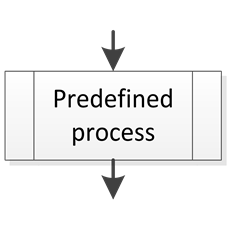A flowchart is a graphical method of presenting an algorithm, usually on paper. It is the visual representation of the algorithm’s flow of execution. In other words, it visually represents how the flow of execution proceeds from one statement to the next until the end of the algorithm is reached. A flowchart cannot be entered directly into a computer as is. It must first be converted into a programming language such as C++, C#, or Python.
The basic symbols that flowcharts use are shown in the table that follows.
| Flowchart Symbols and Their Functions | |
|
|
Start/End: Represents the beginning or the end of an algorithm. The Start symbol has one exit and the End symbol has one entrance. |
|
|
Arrow: Shows the flow of execution. An arrow coming from one symbol and ending at another symbol shows that control passes to the symbol that the arrow is pointing to. Arrows are always drawn as straight lines going up and down or sideways (never at an angle). |
|
|
Process: Represents a process or mathematical (formula) calculation. The Process symbol has one entrance and one exit. |
|
|
Data Input/Output: Represents the data input or the results output. In most cases, data comes from a keyboard and results are displayed on a screen. The Data input/output symbol has one entrance and one exit. |
|
|
Decision: Indicates the point at which a decision is made. Based on a given condition (which can be true or false), the algorithm will follow either the right or the left path. The Decision symbol has one entrance and two (and always only two) exits. |
|
|
Definite Loop: Shows the repetition of a statement or a block of statements for a predefined number of times. The Definite Loop symbol has one entrance and one exit. |
|
|
Off-page connectors: Show continuation of a flowchart onto another page. They are used to connect segments on multiple pages when a flowchart gets too big to fit onto one sheet of paper. The outgoing off-page connector symbol has one entrance and the incoming off-page connector symbol has one exit. |
|
|
Subprogram (predefined process): Depicts subprograms that are formally defined elsewhere, such as in a separate flowchart. The Predefined process symbol has one entrance and one exit. |
The following is an example of a flowchart. The algorithm prompts the user to enter three numbers and then calculates their average value and displays it on the computer screen.

Remember! A flowchart always begins and ends with a Start/End symbol!
Exercise – Finding the Average Value of Three Numbers
Design an algorithm that calculates the average value of three numbers. Whenever the average value is below 10, a message “Fail!” should be displayed. Otherwise, if the average value is 10 or above, a message “Pass!” should be displayed.
Solution
In this problem, two different messages must be displayed, but only one can appear each time the algorithm is executed; the wording of the message depends on the average value. The flowchart for the algorithm is presented here.

Notice: To save paper, you can prompt the user to enter all three numbers using one single oblique parallelogram.
Remember! A Decision symbol always has one entrance and two exit paths!







